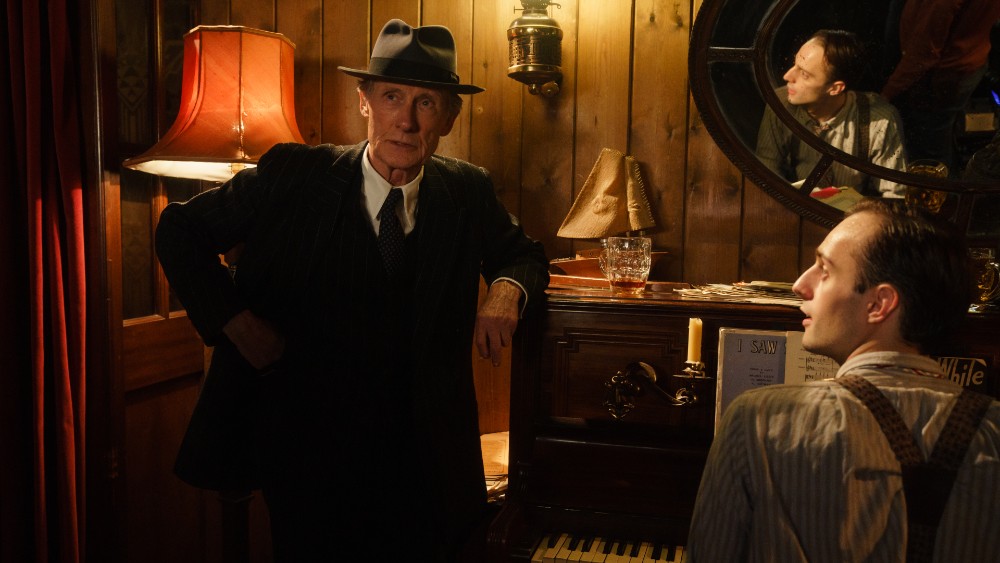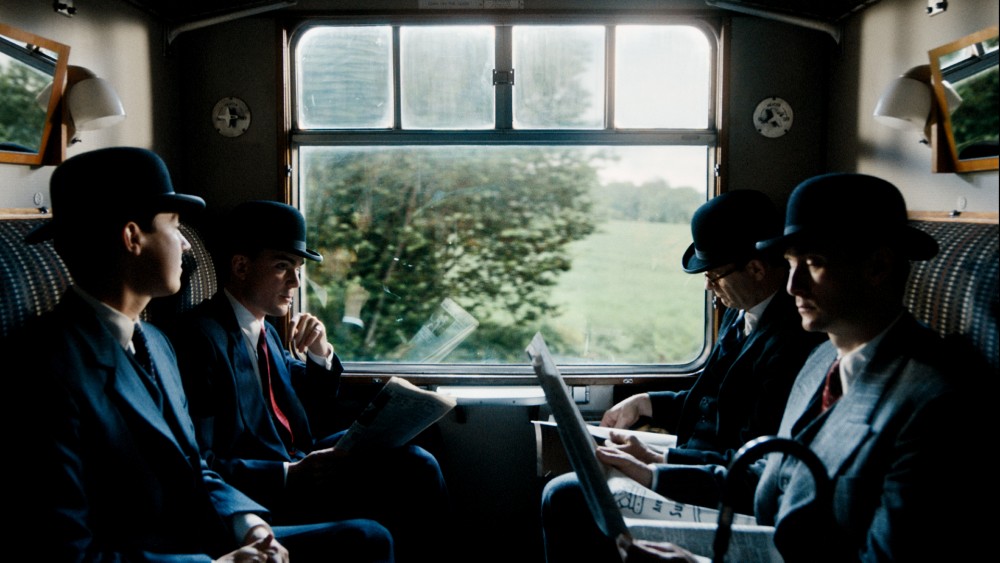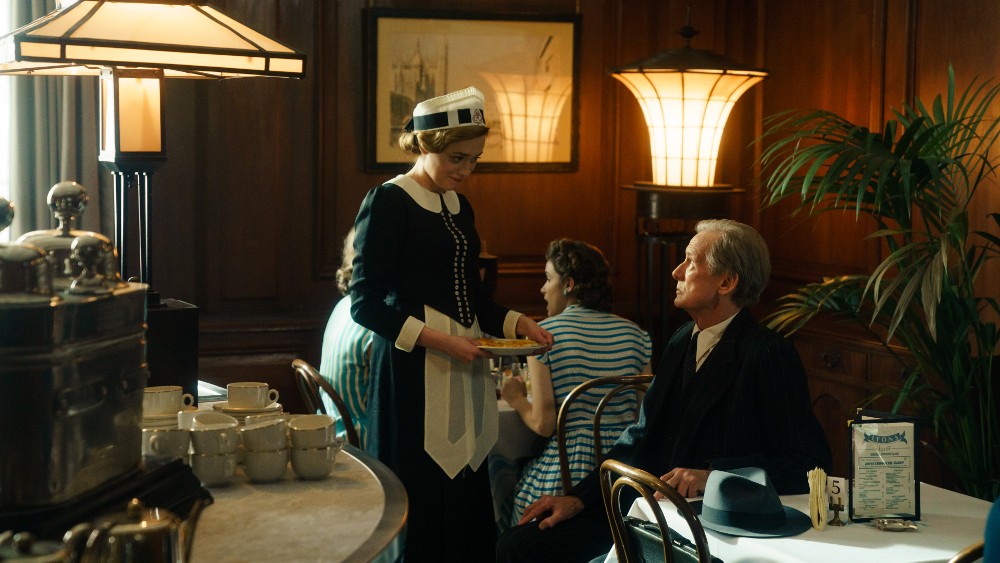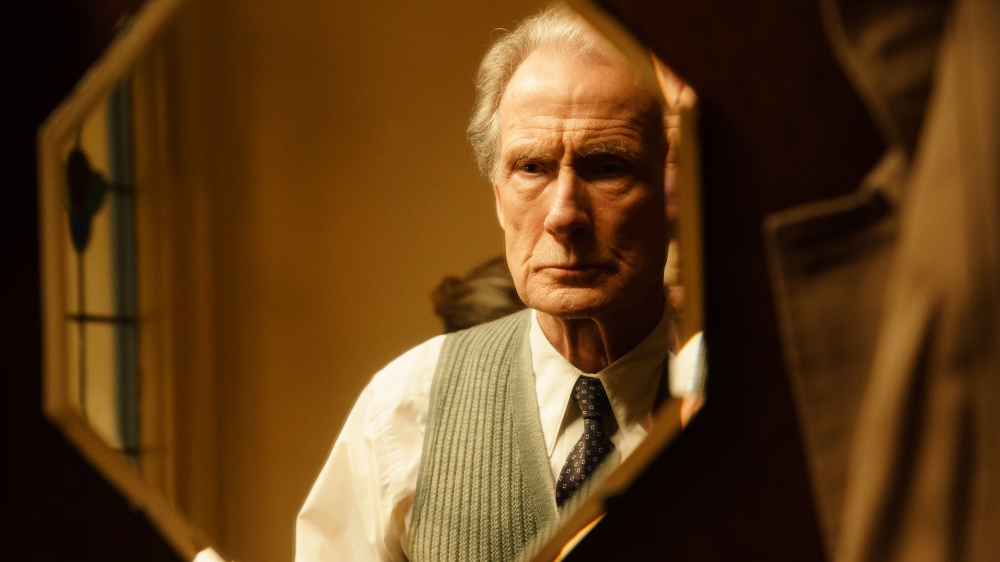The idea of remaking a classic like Akira Kurosawa’s 1952 drama Ikiru might not seem like a particularly prudent decision, but that’s exactly what Director Oliver Hermanus has done with Living, transporting the story to ’50s London with Bill Nighy playing Mr. Williams, a lifelong public servant diagnosed with terminal cancer who tries to make the most of his last few months.
While Kurosawa’s film was contemporary at the time of its release, Living is a period piece, and Hermanus wisely called upon one of Hollywood’s top Costume Designers, three-time Oscar winner Sandy Powell, to design the costumes. Powell has worked quite regularly with filmmakers such as Martin Scorsese and Todd Haynes, and she has won a trio of Oscars for her work on Shakespeare in Love, The Aviator, and The Young Victoria, in addition to receiving 12 other Oscar nominations, including dual nominations in both 2016 (Carol and Cinderella) and 2019 (The Favourite and Mary Poppins Returns).
Though Below the Line has spoken to Powell a number of times over the years, this was a particularly special conversation in which we not only talked about her work in Living but also about an amazing bit of philanthropy she organized two years ago for a very good cause.

Below the Line: I know you’ve spoken quite a bit to Below the Line over the years, and I feel kind of pretentious whenever I speak with costume designers because I’m not even remotely fashionable.
Sandy Powell: No. You see, this is where you’re wrong. Costume design isn’t about fashion. Fashion is fashion. Costume design is characters and costumes, so nothing to do with whether you’re fashionable or not, or understanding fashion.
BTL: A lot of the people you dress for your movies do look quite fashionable, though.
Powell: Maybe that’s to do with the kind of films they’re in or the parts they’re playing.
BTL: I know Living was at Sundance, so you finished it some time ago. When did you first hear about the project, and what got you interested in it? Had you worked with Oliver before?
Powell: I had never worked with Oliver before. I had seen his film Moffy, but that was it. I came to the film through Steven Woolley, the Producer, who I’ve known for a million years [and] who I did some of my very first films with during the early ’90s. He came to me with it and said that he had this film that was [a] remake of the Kurosawa [film], and this really great, interesting director [named] Oliver Hermanus. I came to it that way. I read it, rewatched the film, and met Oliver, who I really liked, so that’s how I came to be doing Living.
BTL: I know you’ve worked with Martin Scorsese and Todd Haynes a lot, as well as designed costumes for Disney movies like Cinderella and Mary Poppins, but otherwise, how do you decide whether to take on a project? Is it about the filmmaker as much as it is about the script?
Powell: I mean, yes, in the films that aren’t Disney, it’s script and director, basically. So either a director I know… obviously, I’m going to do a film with Martin Scorsese or Todd Haynes if they ask me because I know them, and I know it’s gonna be good, whatever it is. On a meeting with a director, either I know the director’s work to begin with, or I meet them, and [if] I really like them and [I’m] inspired by them, then I would want to do the job, but I have to really like the script.
Now, if I don’t like the script, or if the script is something that I wouldn’t be interested in seeing myself once it was made, I wouldn’t want to do it. I’m only interested in doing things that I really think are great, and also, that’s got something for me to do, [and] that I’m going to enjoy doing. I actually don’t think I could produce good work on something I didn’t care about.
BTL: For this one, did you watch Kurosawa’s film?
Powell: I did at the very beginning, and I think I watched it before reading the script. I’m pretty sure that Steven told me about the film, so I started by watching the film. Which was great, it was really interesting, but then reading the script and then realizing “Okay, well, I’ve seen Ikiru now. I get the gist of it.” There wasn’t any reason for me to refer back to it visually.
BTL: When you take on a movie like this, what kind of research are you doing? I see you have many shelves of books behind you.
Powell: You know what? I start every project in this room. I start every project [with] my bookshelves because there will be something there. Obviously, I have books on [the] history of costume, but I also have hundreds of books of photography, [and] art books. So I will start with what I have in the room, and then, of course, you just carry on your research. Actually, a lot of it is done here. I did find a lot of photography books that were really useful for researching this period — 1953 London — including photography books. Cecil Beaton‘s got a bunch of photographs of models having their photographs taken amongst bomb sites and bomb ruins in London. [So] I start there and then go further afield, and then, like usual, you end up looking online for images. So pretty much just looking at images of real people in this period, because the idea was to recreate everything as authentically as possible. We weren’t trying to do anything stylized or heightened. It was about real life and real people. That’s where the research always starts. I like old-fashioned books.
BTL: After reading the script and meeting Oliver, are you starting your prep at the same time as, say, the production designer?
Powell: Yes, we did, actually. I think we had something like six weeks or seven weeks, a very short prep time, to get everything together. This was a small-budget film with not a great deal of time, so we sort of hit the ground running, really; we had very little time. Fortunately, for everybody, we were all under the same roof. Our offices were based in the same building [where] we shot most of the film, which was called County Hall. That was the actual location the film was set in. So we were there, all together. That really helped considering we had so little time. It meant that we could run into each other’s offices, and we could all communicate all the time and see what was going on. Oliver was always available, which is great because quite often, directors aren’t. They’re all over the place.

BTL: I’m not sure how old Bill is, but I assume he was alive in 1953, although he probably was very young. Did he have any thoughts about how Mr. Williams would dress?
Powell: Yes, we had lots of discussions, and Bill had very specific ideas. We both knew it was going to be a suit. He’s a civil servant. He goes to work every day wearing the same suit that he’s been wearing every day for years. Maybe he has two suits, but this covers quite a short period of time. We decided that he just has the one suit. Many men back then would just have the one suit they wore to work, and then maybe he owned another suit that was for Sunday best or something — weddings and funerals.
So it was the suit, and we had to find the perfect suit that was going to be quite somber, quite sober, practical, but kind of worked for his character, in a way. He had to stand out and be noticed, obviously, because he’s the lead, and also, he’s the head of his department, so there has to have a little bit of authority to it, yet nothing that would stand out too much.
BTL: I know that Savile Row is world-famous for its custom-fit suits, which I assume are very expensive, but would someone like Mr. Williams be wearing one of those suits?
Powell: No, actually, I think this character wouldn’t. He’s very suburban, so he wouldn’t have been buying his suits in Savile Row. He probably would have had a very good off-the-peg suit or a suit from a provincial tailor — a small tailoring shop as opposed to Savile Row. Having said that, I did use a Savile Row tailor to do some alterations on the suit that he actually wore. The suit that he is actually wearing, believe it or not, is an original suit from the period, or even from earlier. Back in 1953, [with] a character of his age, it would be unlikely that he would be wearing a brand new suit. He seemed an unlikely character, [as] he wouldn’t have spent any money on a brand new suit at [that] time in his life, so he is wearing a suit that is 20 to 25 years out of date.
BTL: Where can you find a suit like that? It’s amazing that it would still even be wearable at that point.
Powell: It is amazing, actually, but the thing about suits that were made that long ago [is], they’re made [of a] wool and fabric that is so much sturdier than the fabrics now. I mean, the wool suits back then, they’re like armor. They’re like really heavy-duty. And it’s not only how they were made of wool, but they were also to keep warm. Nowadays, men’s suiting is really fine and floppy, and it’s because no one needs to keep warm, wearing their suits; everywhere is heated. Where we find original clothing like that [is] in costume rental companies, and there are plenty of those. There’s a particularly huge one in London called Angels, which people come from all over Europe and the U.S. to use, and they have hundreds of thousands of items of clothing across all periods. That’s where you begin, and it’s like a massive warehouse space, and you have to go down suit after suit after suit, which is a long, laborious job, actually trying to find the [perfect suit], because they all look the same after a while. And then, you have to find the one that is going to a.) fit and b.) be right for the character and have everything else that it needs. That’s where I found it, after a lot of digging and delving.
BTL: How much input does Bill have as far as the suit? Does he just put it on and go, “Yeah, I like this one.”
Powell: Absolutely, completely. Bill — or any actor, for that matter — I [have them] start by trying on various, different versions of the thing they’re going to wear. I gather as many things… not too many [as] to be overwhelming, but let’s say a dozen suits that are within the realm of what we’re looking for, and [have them] try them all on. Whether it’s a single-breasted, a double-breasted, a three-piece or a two-piece, a brown or a blue or a gray. He was never gonna wear a brown suit, quite honestly, but it was going to be a navy or a gray, and we settled, in the end, on the dark charcoal gray. Having sort of gone through various things, the minute we put this particular suit on, we both knew it was the right one.
That’s generally how it works at a fitting if you’re trying things on. It’s the moment when both the costume designer and the actor know that it’s the right suit, or it’s sort of — and it sounds rather corny — but the character appears in the room. Suddenly, it’s not Bill in the suit, it’s, “Ah, there’s Mr. Williams.”

BTL: When I rewatched Living, the first 15 to 20 minutes of the movie mainly concerns men of varying ages in different suits. How did you figure out how to differentiate between them, as far as who would wear which suit? Is any of that in the script or did it come out of conversations you had with Oliver?
Powell: That was the biggest challenge, and it always is. If you’re doing a bunch of men in suits [laughs], and I’ve done quite a lot of men in suits over the past… it is about “how do you make them different?” Essentially, they’re all wearing the same kind of thing. It’s a jacket and a pair of trousers and a vest, or not. How do we differentiate them? To begin with, the older actors, I would always have in suits that are backdated. Like I said before, [I] assume they’re not going to be buying new suits, so they’re going to have things that are 10, 20, even 30 years old. So that’s a specific look.
The younger characters have much more contemporary-looking suits. The three younger characters, two of them are in double-breasted suits, which I thought was a little bit more fashionable, and they’re also in lighter colors. I have the older guys in dark grays and dark navys, and the younger characters in lighter tones of blue. I do the same with each of the actors. I have a bunch of suits to put on them, and what happens is, you end up with the right suit for the right character and physicality. We were fortunate enough to end up with everybody. I mean, they’re all completely different looking and sized people, but they do all look individual and [you] can differentiate one from the other.
BTL: I’ve never worked in an office like that, and obviously not back then. But if you saw these men in these suits, would you be able to tell the hierarchy in whatever office they were working?
Powell: Not necessarily… Well, actually, back then? Yes, because there are people who are higher up. Mr. Williams isn’t the highest — he has somebody higher than him — and he wears a much more formal outfit, which is called a Morning suit, where he’s got a gray and black-striped trouser, and a black swallowtail coat, which is a more traditional, very old-fashioned look. That was much more formal, and the people right at the top [would] be wearing that. So in that sense, [yes,] but generally, no. Back then, every man would have a tie, a plain white shirt, generally, and a suit. So not necessarily. I mean, age will probably give you the hierarchy more than anything else.
BTL: What happens to all the suits once a show wraps? Do they go back to some warehouse or that place you mentioned earlier?
Powell: A lot of the things were rented, so they go back to where they were rented from.
BTL: After Mr. Williams gets his terrible diagnosis, he goes out into the world, and we get to see a lot more of the British class system of the time. I’m not sure that’s something you can necessarily see nowadays — certainly not in New York — whereas back then, you could definitely tell the difference between the classes more.
Powell: You could, and that’s where the importance of the extras comes in the background. I mean, the background really tells a story. The background literally provides the background for the action to be happening. It actually tells you where you are in the world or in the place. As you say, you can really tell the difference [between] the classes. Nowadays, people dress a lot less formally. Nowadays, it just seems that everybody is in comfort wear, whether they’re doing an important job or not. Even now, when I look at men in the city going to work in suits, they look terrible, because everybody wears off-the-peg suits that don’t really fit very well, and they’re really horrible, and they’re wearing them because that’s what they have to wear. They’re not wearing them because they like them. Very rarely do you see a man on the street in a beautifully-fitted suit, and if you do, I really notice them.

BTL: You talk about the background actors in the arcade scenes. I’m not sure where that region was, but did you have to do a lot of research into that as well?
Powell: Do you mean when he goes away to the seaside town? I think it was meant to be somewhere like Brighton, which is [on] the south coast. It’s the nearest kind of coastline to London, which is about 50 miles away. Traditionally, [it’s] where people from London would go for their holidays, or there are people who live down there. Obviously, what we showed there [were] predominantly working-class people, out in bars and pubs and restaurants and enjoying themselves [at] the fairground, in the arcades. That’s where we have fun dressing the extras, because when we’re dressing extras, you have to invent characters for each of them as well, to make it make sense, to make it look like believable groups of people who aren’t all dressed the same, who aren’t uniformly dressed. That’s where we have to have lots of different sorts of things going on, and they are as important as the principal characters that we’re looking at as well.
BTL: Was this shot during the pandemic or was it just before?
Powell: It was one of those [made] just after, but every day, it was, like, masks on all day long at work, and testing the whole time. And all those restrictions made things quite difficult, but it was just after everybody was getting back to work.
BTL: It must have been harder for you and your department because you can’t really do fittings without getting close to the actors.
Powell: Well, [we’re] just all masked up, so it’s a bit difficult, but it became a way of life. I did a couple films during that whole time, and then even after that, last year, when I was doing Snow White, when there was no pandemic, we still had to… I mean, basically, the rest of the world [wasn’t] wearing masks. We had to wear masks all day long, every day.
BTL: It’s cool that you also did Snow White, as I’ve known Marc Webb for quite some time. Did you have to recreate costumes like Snow White’s iconic outfit from the original animated movie?
Powell: I don’t know how much we can talk about this, but it’s not about recreating something from the original. Obviously, there is a nod to the original, and the character has to be recognizable as Snow White, but it’s a new version. In the same way as I did Cinderella, it’s a nod to the original animation everybody knows, but it’s the new version. But it couldn’t be [a] more polar opposite to Living, with a six-week prep. I mean, that was 10 months of my life, and we made every single costume you see in the film, and there are thousands of extras, and every single costume, every single thing was made for all the principals and so it was fabulous. I mean, it’s a luxurious amount of time to actually get something done, and it’s great to be able to do that. I mean, I love designing and making everything from scratch, and that’s what I was able to do.

BTL: It’s lovely talking to you. I was looking at your Instagram earlier, and I saw that coat of signatures that was being auctioned off, so how much did it eventually go for?
Powell: Well, it got 16,000 pounds in the auction, but actually, every time I Instagrammed a new signature, the online donations went up. Somebody calculated that it raised around 100,000 [pounds], which is fantastic, and it’s now in the Victorian Albert Museum on permanent display, so the person who actually bought it at the auction very kindly donated it to the V&A Museum.
BTL: What gave you the idea to do that?
Powell: Well, two things. I mean, one, we were thinking of ways to raise money for the cause, which was to raise money to save Derek Jarman‘s home prospect cottage and turn it into an artist residency, as opposed to being sold off privately. That was the main reason. I was very much involved in that, thinking, “Okay, well, how can we come up with ideas to raise money or to get donations up?” It coincided with my nomination for The Irishman, which I absolutely wasn’t expecting to happen. I kind of thought, “That’s not an Oscar costume film.” I really, really thought that, and [then] I got a BAFTA nomination [and] an Oscar nomination.
Of course, one of the first things you think of is “Oh, God, I’ve got to think of something to wear.” And there was a lot of talk about sustainability and not spending loads of money on outfits. And I thought, “Great, okay, I’m not gonna spend money on an outfit. What can I do?” What that white suit actually was, it’s called a toile, which is a pattern for another suit that was made the year before, or a couple of years before. A friend of mine made me suits for the award ceremonies back then and this was calico — it’s cotton muslin, and it’s the suit you make up first to try on to get the fit, right. Usually, you throw those away afterward. Well, it still existed, so that’s it. I just wore a white canvas suit, and that was going to be it. I’m just wearing a white canvas suit to the Oscars and the BAFTAS, and then I thought, “Hang on, this is a blank canvas. I could just maybe get people to sign it.” And then once I started, it didn’t stop, and it was in really good fun.
BTL: It’s interesting to hear you say that about The Irishman. I recently spoke with Todd Field, and he was saying how any time someone watches a movie to consider it for costumes, they have to be these big, flashy period pieces, but in movies like The Irishman and Living, every character has a costume that you’ve designed, and it’s equally impressive.
Powell: Exactly. Of course, I was thrilled that The Irishman was noticed because it is people in ordinary… I was gonna say “ordinary people”; they’re not very ordinary people, are they? But they’re not fashionable people. They’re not kings and queens and princesses, which is what a lot of people expect from costume dramas, and they’re not “historical” historical. It’s normal clothing, and I’m glad it got recognized, because, of course, it’s crucial. It’s about character development [and] it’s about making the characters believable. That’s why I’m pleased some people are noticing Living, because it’s really important how it looks.
Also, I just think, in collaboration with the production design, and cinematography and hair and makeup… in Living, all of those things really do all come together under the guidance of Oliver. I think it actually does look beautiful. For a film that’s about an ordinary man, having an ordinary life, I think it looks lovely. In a way, I think it’s an unusual film because it feels really old-fashioned, but not in an “old-fashioned” way. It feels like something you’re not used to seeing, but it doesn’t feel dated. That’s what I mean. It’s like a new way of doing something that’s old-fashioned.
BTL: It really helps put you right back into London during that time period.
Powell: It’s like the opening credits, which was original footage, which I think looked gorgeous. When I first saw that, I was thinking, “Oh my god, now it’s gonna segue into our costumes, and it’s going to look like costumes.” And it doesn’t. I think it actually works really well. It’s sort of quite seamless.
Living is now playing in select cities courtesy of Sony Pictures Classics.





